Folk costume
A folk costume (also regional costume, national costume, traditional clothing, traditional garment or traditional regalia) expresses an identity through clothing or costume, which is usually associated with a geographic area or a period of time in history. It can also indicate social, marital or religious status. If the costume is used to represent the culture or identity of a specific ethnic group, it is usually known as ethnic costume (also ethnic dress, ethnic wear, ethnic clothing, traditional ethnic wear or traditional ethnic garment). Such costumes often come in two forms: one for everyday occasions, the other for traditional festivals and formal wear. The word "costume" in this context is sometimes considered pejorative due to the multiple senses of the word, and in such cases "regalia" can be substituted without offense.[1]

| Part of a series on |
| Costume |
|---|
 |
| Part of a series on |
| Western dress codes and corresponding attires |
|---|
|
Legend:
|
Following the rise of romantic nationalism, the pre-industrial peasantry of Europe came to serve as models for all that appeared genuine and desirable. Their garments are crystallized into so-called "typical" forms, and enthusiasts adopted that attire as part of their symbolism. These garments may be made from traditional pre-industrial textiles, in regional styles.
In areas where Western dress codes have become usual, traditional garments are often worn at special events or celebrations; particularly those connected with cultural traditions, heritage or pride. International events may cater for non-Western attendees with a compound dress code such as "business suit or national dress".
In modern times, there are instances where traditional garments are required by sumptuary laws. In Bhutan, the traditional Tibetan-style clothing of gho and kera for men, and kira and toego for women, must be worn by all citizens, including those not of Tibetan heritage. In Saudi Arabia, women are also required to wear the abaya in public.
Africa
Central Africa
- Cameroon – Pagne (female), Toghu (male)
- Central African Republic – Pagne
- Democratic Republic of the Congo – Pagne
- Equatorial Guinea – Pano
- Gabon – Pagne
- Republic of the Congo – Pagne
- São Tomé and Príncipe – Pano
Eastern Africa
- Burundi – Imvutano
- Comoros – Lesso (female), Kanzu (male)
- Djibouti – Macawiis (male), Koofiyad (male), Dirac (female), Garbasaar (female); the Afar people have their style of traditional clothing.
- Eritrea – Kidan Habesha (male), Zuria or Habesha kemis (female)
- Ethiopia – Ethiopian suit or Kidan Habesha (male), Habesha kemis (female); each ethnic group has a traditional style of dress.
- Kenya – Does not have a national costume. All tribes have their respective traditional garments, for example: Maasai traditional costume: Kitenge, Kikoi, Maasai beadwork
- Madagascar – Lamba
- Mauritius and Réunion – Sega dress
- Rwanda – Mushanana
- Seychelles – Kanmtole dress
- Somalia – Kanzu or Khamiis, Macawiis (male), Kitenge Koofiyad (male), Dirac (female), Guntiino (female), Garbasaar (female)
- Sudan – Jalabiyyah, Taqiyyah, and Turban (male), Toob, a cotton women's dress (female)
- Tanzania – Kanzu and Kofia (male), Kanga (female)
- Uganda – Kanzu and Kofia (male), Gomesi (female), Mushanana (Female - South Western Uganda)
Northern Africa
- Algeria - Burnous, Caftan, Caftan El-Bey, Gandoura, Haïek, Jellaba, Mlaya, Sarouel
- Bikhmar (Ouargla)
- Blouza (Oran)
- Chedda (Tlemcen)
- Chemsa (Jijel)
- Fergani (Constantine)
- Gandoura Annabiya (Annaba)
- Ghlila, Karakou, Sarouel Mdawer (Algiers)
- Labsa M'zabia (M'zab)
- Labsa Naïlia (Ouled Naïl)
- Lefa we dlala (Annaba)
- Melhfa Chaouïa (Aures)
- Melhfa Sahraouia (Tindouf)
- Qashabiya (Djelfa et Laghouat), Labsa Kbaylia (Kabylie)
- Binouar - Sétif
- Labsa Touratia (Hoggar)
- Egypt – Galabeya
- Libya – Jellabiya, Farmla (an embroidered vest), Fouta
- Morocco – Djellaba, Fez hat and Balgha (male), Takchita (female)
- Sahrawi Arab Democratic Republic – Darra'a (male), Melhfa Sahraouia (female)
- Tunisia – Jebba, Chechia, Fouta
Southern Africa
- Angola – Pano
- Botswana - leteisi and Tshega
- Lesotho – Shweshwe clothing and blankets, Mokorotlo
- Malawi – Chitenje
- Mozambique – Capulana
- Namibia – Herero traditional clothing
- South Africa –
- Sotho: Shweshwe clothing and blankets, Mokorotlo
- Xhosa: Umbhaco
- Zulu: Isicholo
- Afrikaners and Rooineks: slouch hat, safari shirt, veldskoen, knee-high socks, khaki Bermuda shorts or trousers.
- Zambia – Chitenje
- Zimbabwe – Chitenje
Western Africa
- Benin – Dashiki suit and Aso Oke Hat (male), Buba and wrapper set (female)
- Burkina Faso – Batakari (male), Kaftan (female)
- Cape Verde – Pano de terra
- Côte d'Ivoire – Kente cloth (male), Kente kaba and slit set (female)
- Gambia – Boubou (male), Kaftan (female)
- Ghana – Kente cloth or Ghanaian smock and Kufi (male), Kente kaba and slit set (female), Agbada (male)
- Guinea – Boubou (male), Kaftan (female)
- Guinea-Bissau – Ethnic clothes of Guinea-Bissau; for example: Fula: Boubou (male), Kaftan (female)
- Liberia – Dashiki suit and Kufi (male), Buba and skirt set (female)
- Mali – Grand boubou and Kufi (male), Kaftan (female)
- Mauritania – Darra'a (male), Melhfa Sahraouia (female)
- Niger – Babban riga, Tagelmust, Alasho (male), Kaftan (female)
- Nigeria – Agbada, Dashiki or Isiagu and Aso Oke Hat (male), Buba and wrapper set (female)
- Senegal – Senegalese kaftan and Kufi (male), Kaftan (female)
- Togo - Batakari, Agbada or Ewe kente cloth (male), Pagne or kente kaba (female)
Asia
Central Asia
Turkic Countries:
- Kazakhstan – Chapan, Kalpak (male), Saukele, Koylek (female)
- Kyrgyzstan – Chapan, Kalpak (male), Saukele, Koylek (female)
- Turkmenistan – Chapan
- Uzbekistan – Khalat, Tubeteika, Chapan, Turban, Paranja
East Asia
- China – Cheongsam and Changshan and Hanfu(de facto; each ethnic groups of China have their own traditional costume)
- Japan – Wafuku: Kimono, Junihitoe, Sokutai
- Fukuoka Prefecture – Mizu happi and Shime-komi
- Hokkaido – Ainu clothing
- Ryukyu – Ryūsō/Ryusou
- Korea – Hanbok (South Korea)/Chosŏn-ot (North Korea)
- Mongolia – Deel
- Taiwan - Aboriginal groups in Taiwan conserve traditional indigenous styles; popular styles include Amis, Atayal, Bunun and Paiwan styles
North Asia
- Russia (Urals, Siberian Federal District and Far Eastern Siberia) – Clothing of Siberian nationalities (Buryat, Yakut, Altai, etc.)
South Asia
- Afghanistan – Pashtun dress: Afghan cap, turban, Shalwar Kameez (male), Firaq partug, Burqa, Chador (veil) (female)
- Bangladesh – Sherwani and Kurta (male), Sari and Long Skirt, Mexi,[2] (female)
- Bhutan – Gho (male) and Kira (female)
- India – Achkan, Shalwar Kameez, Sherwani, Dhoti, Phiran, Churidar, Kurta, Turban (male) and Sari, Patiala salwar, Lehenga, Choli, Pathin (female)
- Maldives – Dhivehi libaas (women) and Dhivehi mundu (men)
- Nepal – Daura-Suruwal and Dhaka topi, (male) and Gunyou Cholo (female); Traditional Newar, Sunuwar, Rai, Limbu ([bakku, chuwa])clothing
- Pakistan – Peshawari turban, Shalwar Kameez, Churidar (male), Shalwar Kameez and Dupatta (female), Punjabi turban
- Sri Lanka – Kandyan sari (female)
Southeast Asia
- Brunei – Baju Melayu, Songkok (male), Baju Kurung, Tudung (female)
- Cambodia – Sampot, Apsara, Sabai, Krama, Chang kben
- East Timor – Tais cloth clothing
- Indonesia – (See: National costume of Indonesia). There are hundreds of types of folk costumes in Indonesia because of the diversity in the island nation. Each ethnic group of Indonesia have their own traditional costume;
- Batak tribe: Ulos
- Javanese people: Beskap, Batik shirt, Blangkon, Songkok, Sarong (male), Kebaya, Tudung, Sarong (female).
- Malay people: Baju Melayu, Baju Kurung, Songket
- Papua: Koteka
- etc.
- Laos – xout lao, suea pat, pha hang, pha biang, sinh
- Malaysia – Baju Melayu and Songkok (male), Baju Kurung, Baju Kebarung (Kebaya/Kurung hybrid), Tudung (female); every state has its style of baju including a special baju for the Federal Territories.
- Myanmar – Longyi, Gaung baung
- Philippines – Barong (male) and Baro't saya; Maria Clara gown, Terno (female), Malong, Patadyong, Tapis, Salakot
- Singapore:
- Chinese Singaporeans - Hanfu, Cheongsam (female), Tangzhuang (male),Changpao (male)
- Indian Singaporeans - Sari (Female), Dhoti (Male), Kurta
- Malay Singaporeans - Baju Melayu (Male), Baju Kurung (female), Sarong
- Peranakans - Kebaya (female), Baju Lokchuan (male)
- Thailand – Chut thai, Pha chung hang, Pha biang (both genders), Pha nung, Sinh, Thai Chakkri (female) Raj pattern, Suea Phraratchathan (male)
- Vietnam – Việt phục: Áo giao lĩnh, Áo dài, Áo tứ thân, Áo bà ba, Áo ngũ thân
West Asia
- Armenia - Armenian dress, Arkhalig, Arakhchin, Burka, Chokha, Kalpak, Papakha, Shalvar
- Azerbaijan – Azerbaijani traditional clothing: Arkhalig, Chokha, Kelaghayi, Kalpak
- Cyprus - Zimbouni (waistcoat) and Vraka (breeches) (men) and Saiya (formal festival dress) (women)
- Turkish Republic of Northern Cyprus - Cepken(Yelek)-Vest, Salta, Yazma, Potur, Boynuz Kemer
- Israel – Sudra, Tanakhi sandals, Tembel hat, Yemenite Jewish clothes; Jewish religious clothing: Rekel, Bekishe, Tzitzit, Kippah, Tichel.
- Iran – Chador, Turban, Thawb (Dishdasha/Kameez), Kurdish clothing, Zardozi, Battoulah
- Iraq – Assyrian clothing, Keffiyeh, Hashimi Dress, Bisht, Dishdasha, Kurdish clothing, Agal, Bisht
- Jordan – Keffiyeh, Bisht, Thawb, Bedouin clothing
- Lebanon – Tantour, Labbade, Sherwal, Keffiyeh, Taqiyah
- Kuwait – Dishdasha, Keffiyeh
- Oman – Dishdasha, Khanjar, Keffiyeh
- Palestine – The Arabic-speaking regions formerly part of Mandatory Palestine (Modern day Israel , West Bank , and the Gaza Strip ) have a specific design of a traditional costume, the thobe, not to be confused with the Arabian Peninsula men's garment of the same name, with those of Bethlehem and Ramallah being the most popular varieties. The Palestinian style of keffiyeh is regarded as a popular headdress and symbol of Palestinian identity.
- Qatar – Thawb, Keffiyeh
- Saudi Arabia – Thawb, Ghutrah, Agal, Bisht, Abaya, Jilbab, Niqab
- Syria – Dishdasha, Sirwal, Taqiyah, Keffiyeh
- Turkey - Kalpak, Yazma, Kaftan, Turban, Salvar, Çarık,Cepken-Yelek, Boynuz Kemer -Horn belt
- United Arab Emirates – Kandura, Thawb, Abaya; older women would still wear the battoulah visor
- Yemen – Thawb, Izaar, Turban, Jambiya, Niqab
Europe
| Part of a series on |
| Western dress codes and corresponding attires |
|---|
|
Legend:
|
Eastern Europe
- Belarus – Slutsk stash, the national type of wimple (namitka)
- Georgia – Chokha (Every region has its own specific design of Chokha), Papakha
- Ossetia – Chokha
- Russia – Bast shoes, Boyar hat, Ryasna, Sarafan, Kaftan, Kokoshnik, Kosovorotka, Ushanka, Valenki; (Sami) Gákti, Luhkka for colder weather
- Caucasus republics (for example, Chechnya, North Ossetia-Alania and Adygea) – Chokha, Papakha, Ushanka in cold weather
- Mordovia - Mordovian national costumes
- Ukraine – National costumes of Ukraine: Vyshyvanka, Sharovary, Żupan, Ukrainian wreath
Central Europe
- Austria - Each state has a specific design on national costume; the most famous is that of Tyrol, consisting of the characteristic Tyrolean tracht and dirndls.
- Czech Republic – Kroje
- Hungary – National costumes of Hungary
- Poland – Czamara, Żupan, Kontusz, Rogatywka (National costumes of Poland)
- Slovakia – Kroj (embroidered traditional dress)
Northern Europe
- Denmark – Folkedragt
- Faroe Islands – Føroysk klæði
- Greenland – Anorak
- Estonia – Rahvariided[3]
- Finland – Every region has its own specific design of national costume (kansallispuku, nationaldräkt). These vary widely. Many of them resemble Swedish costumes, but some take influences from Russian costumes as well. For the Sami in Finland, each place has its own Gákti or Luhkka for colder weather.
- Iceland – Þjóðbúningurinn
- Ireland – Aran sweater, Irish walking hat, flat cap, Grandfather shirt, Galway shawl, brogue, Irish stepdance costume
- Latvia - Tautastērps
- Lithuania - Tautinis kostiumas
- Norway – Every county (including Svalbard, which isn't a county) has a designated style of folk costume, or Bunad; the most famous bunader come from Hardanger and Setesdal; Sami: Gákti, and for colder weather, Luhkka
- Sweden – the traditional folkdräkt has been specific to the local region and varied from province to province but has since 1983 been supplemented by an official National Costume, Sverigedräkten, common for all; 18th century: Nationella dräkten; Sami: Gákti, Luhkka for colder weather
- United Kingdom: Every constituent country has its own national costume.
- England – English country clothing, Morris dance costumes, Flat cap, English clogs
- Cornwall – Sou'wester hat, fisherman's smock, gansey, bal-maiden clothing, Cornish kilts and tartans
- Lancashire – Lancashire shawl, English clogs
- London – Pearly kings and queens
- Northumbria - Maud, blue bonnet, Rapper dance costumes, Northumberland kilts and tartan
- Southern England – Smock
- Northern Ireland: Similar to the rest of Ireland.
- Scotland – Highland dress: Kilt or trews, tam o'shanter or Balmoral bonnet, doublet, Aboyne dress, and brogues or ghillies.
- Scottish Lowlands: Similar to Northumbria – Maud, blue bonnet
- Wales – Traditional Welsh costume
- England – English country clothing, Morris dance costumes, Flat cap, English clogs
Southern Europe
- Albania – Albanian Traditional Clothing, Fustanella, Tirq, Xhamadan, Opinga
- Andorra – Barretina, espadrilles
- Bulgaria – Every town has its own design of a national costume (nosia), with different types of clothing items traditional for each of the ethnographic regions of the country.[4][5]
- Croatia – Croatian national costume, Lika cap, Šibenik cap
- Greece – Fustanella, Breeches (Vraka), Amalia costume.
- Greek fisherman's caps in many coastal villages by the Aegean sea.
- Italy – Italian folk dance costumes; Roman clothing: Toga, Stola
- South Tyrol – Tracht and Dirndl
- Sardinia – Every town has its design of the traditional folk costume (see also Sardinian people for more information).
- Sicily – Coppola, Arbereshe costumes
- Kosovo – Traditional clothing of Kosovo, Qeleshe, Tirq, Xhubleta, Xhamadan, Opinga
- Malta – Għonnella
- Montenegro – Montenegrin cap
- North Macedonia – Macedonian national costume
- Portugal – Every region has its own specific design of a national costume. The most famous costumes come from Viana do Castelo and Nazaré.
- Romania – Romanian dress
- Serbia – Every region has different design of a national costume. Serbian traditional clothing, Lika cap, Montenegrin cap, Opanci, Šajkača, Šubara
- Slovenia – Gorenjska narodna noša
- Spain – Every autonomous region has its own national costume.
- Andalusia - Sombrero cordobes, traje de flamenca, traje de luces, montera
- Basque Country – Beret, espadrilles
- Canary Islands - Every island has its specific style of traditional dress. Néstor Martín-Fernández de la Torre designed a costume in Gran Canaria in 1934 to serve as pan-islander costume for all islands, but only caught on in Gran Canaria, being specific to its capital city Las Palmas.
- Catalonia - Barretina, Faixa
- Galicia - Each province has its regional costume.
Western Europe
- Belgium – Bleu sårot (Wallonia)
- France – Every administrative region has a style of folk costume, varying by department. For example, Brittany, with Breton costume varying by department and predominantly used in Cercles celtiques, pardons and festivals.
- Germany – Every state has its own specific design of a national costume (Tracht). For example, Bavaria's well-known tracht: Lederhosen and Dirndl.
- Liechtenstein – Tracht, Dirndl
- Netherlands – Many areas, villages and towns used to have their own traditional style of clothing. In the 21st century, only a few hundred people still wear the traditional dresses and suits on a daily basis. They can be found mainly in Staphorst (about 700 women), Volendam (about 50 men) and Marken (about 40 women). Most well-known parts of Dutch folk costumes outside the Netherlands are probably the Dutch woman's bonnet and klompen.
- Switzerland - Every canton has a specific design of national dress. The most famous Swiss costumes come mainly from the German-speaking cantons of Appenzell, Bern and Zug.
North America
Caribbean
- Antigua and Barbuda – plaid dress, with white pinafore for women, designed by Heather Doram
- Bahamas - None, unofficially Androsia-cloth clothing. Junkanoo costumes can be considered folk costume but fall more into the sector of carnival dress than traditional garment.
- Cuba – Guayabera, panama hat (male), guarachera[6] (female)
- Dominican Republic – Chacabana, panama hat
- Dominica – Madras
- Haiti – Karabela dress (female), Shirt jacket (male)
- Jamaica – Bandanna cloth Quadrille dress (female), Bandanna cloth shirt and white trousers (male), Jamaican Tam
- Puerto Rico – Guayabera, panama hat (male), enaguas[7] (female)
- St. Lucia – Madras
- Trinidad and Tobago – Tobago has an Afro-Tobagonian Creole culture with the Bélé costumes as their typical garment, commonly made of madras. Trinidad, however, has no defined national garment; the two major ethnic groups in the island wear the following during cultural occasions:
- Afro-Trinidadians - Shirt jacket or Dashiki (male), Booboo (female)
- Indo-Trinidadian - Kurta, Dhoti, Sherwani (male), Sari, Choli, Lehenga (female)
Central America
Northern America
- Bermuda – Bermuda shorts
- Canada:
- First Nations – button blanket, buckskins, moccasins, Chilkat blanket, Cowichan sweater, war bonnet. Many communities prefer the word "Regalia" to denote their folk dress.
- Lumberjacks of Quebec and Ontario – Traditional logging wear includes mackinaw jackets or flannel shirts, with headgear being a tuque or trapper hat; a good example is seen with folk characters like Big Joe Mufferaw.
- Maritimes – Acadians wear their traditional heritage clothing on special occasions like the Tintamarre. The Scottish background in Nova Scotia has brought the Nova Scotia tartan as folk wear in the form of kilts, aboyne dresses and trews for Scottish highland dance competitions.
- Métis – Ceinture fléchée, Capote, Moccasins
- Newfoundland - Traditional mummers dress in masks and baggy clothes in Christmas season celebrations; the Cornish influence has also brought yellow oilskins and sou'westers as typical wear in coastal areas.
- Nunavut and other Inuit communities – Parka, mukluks, amauti
- Prairies – Western wear is common on events such as the Calgary Stampede; often worn with Calgary White Hats.
- Quebec and French Canadians – Ceinture fléchée, Capote, tuque
- Mexico – Charro outfit, Guayabera, Sarape, Sombrero (male), Rebozo, China Poblana dress (female); every state has a typical folk dress, for example:
- Chiapas – Chiapaneca
- El Norte – cowboy hats, cowboy boots, bandanna; indigenous communities, like the Yaqui, Seri and Rarámuri, conserve traditional apparel.
- Oaxaca: Tehuana
- Querétaro, Hidalgo and San Luis Potosí - Quechquemitl
- Tamaulipas Cuera tamaulipeca
- Veracruz - Guayabera
- Yucatán – Guayabera (male), Huipil (female)
- United States:
- Alaska – Kuspuks, worn with dark pants and mukluks, as well as parkas are traditional native wear.
- Hawaii – Aloha shirt, Muumuu, Holokū, Pāʻū (skirt; can be made of kapa cloth or grass; modern variations are textile cloth-based with Hawaiian leaf and flower motifs), Malo (loincloth)
- American Southwest, Texas and rural areas in the Midwestern and Western US – Western wear, derived from original Mexican vaquero and American pioneer garb is traditional dress in Texas, the Southwestern US, and many rural communities, including cowboy hats, Western shirts, cowboy boots, jeans, chaps, prairie skirts, and bolo ties.
- Utah – Mormons may dress in 19th-century pioneer clothing for Mormon trek-related activities and events.
- American Upper Midwest, Pacific Northwest, the northern portions of the Great Lakes Basin and northern New England (especially Maine) – Due to the cold weather, the garb in rural areas tends to more closely adhere to heavier materials, such as flannel shirts or Buffalo plaid mackinaw jackets, and a knit cap or, in the case of the Upper Peninsula, a Stormy Kromer cap. A good example is seen in the typical attire of Paul Bunyan, a folk hero popular in areas where logging was a common occupation, as well as lumberjacks working in the area.
- The Amish (mostly found in Pennsylvania, Ohio and Indiana) follow a style of plain dress.
- Deep South –
- Louisiana – The Cajun people of Louisiana traditionally wear the colorful capuchon for Mardi Gras celebrations. Creole women used to historically wear the tignon, mostly in plain or madras fabrics, but it is now sometimes worn for heritage events or cultural reasons.
- South Carolina and Georgia – Gullah communities in the South Carolina Lowcountry and Sea Islands preserve the traditional African-style clothing and culture.
- Nantucket – Summer residents of Nantucket will often wear Nantucket Reds.
- Various styles of Native American clothing; for example, traditional pow-wow regalia for Plains Indians: Moccasins, buckskins, glass beads, breech clouts, and war bonnets or roaches.
- New York – According to folklorist Washington Irving, knickerbockers similar to the breeches of the Pilgrims and Founding Fathers were traditionally worn by many wealthy Dutch families in 19th century New York. Historically, these short pants remained commonplace among young urban American boys until the mid 20th century.
- Patriotic historic European-American costume, especially in the Northeastern United States, includes clothing styles of the Plymouth Pilgrims, Founding Fathers of the United States, William Penn, or Minutemen. (See 1775–95 in Western fashion § Men's fashion.)
Oceania
Australia and New Zealand
- Australia
- Aboriginal Australians: fibercraft-made clothing, possum cloak
- European Australians: cork hat, bushwear: Moleskin trousers, bush shirt, Akubra slouch hat, Driza-Bone coat, Australian work boots
- Torres Strait Islands – Augemwalli
- New Zealand
- Māori – Piupiu, korowai or kakahu huruhuru.
- New Zealand Europeans - Swanndri bush jacket, slouch hat, walk shorts, and knee-high socks; or a black singlet and rugby shorts.
Melanesia
- Fiji – Sulu, Tapa cloth (called masi), I-sala
- New Caledonia – Manou, Robes mission
- Papua New Guinea – Meri blaus, lap-lap, Koteka
- Vanuatu – Aelan dress, Lap-lap
Micronesia
- Federated States of Micronesia - Lap-lap (male), Grass skirt (female)
- Palau - Lap-lap (male), Grass skirt (female)
Polynesia
- Cook Islands – Pareo
- French Polynesia – Pareo
- Samoa – Lavalava, Puletasi, 'ie toga clothing
- Tonga – Tupenu, Ta'ovala, Tapa cloth
South America
- Argentina – Gaucho costume; every province has a specific design of poncho, with the poncho salteño being the most recognized.
- Bolivia – Poncho, Chullo, Andean pollera
- Brazil – Each region has its own traditional costume.
- Bahia – Baiana and Abadá
- Brazilian carnival or Samba costumes for Rio de Janeiro.
- Caipiras (Brazilian country folk) in Sao Paulo, Goiás and other nearby states conserve traditional folk styles of clothing, imitated by participants of festa juninas.
- Gaúcho costumes for Rio Grande Do Sul.
- Indigenous clothes for many states within the Amazônia Legal area
- Northeastern sertão (desert) – Vaqueiro or Cangaceiro clothing
- Chile – Huaso costume: Chamanto, Chupalla
- Colombia – Sombrero Vueltiao, ruana, white shirt, trousers and alpargatas (male), blouse, Cumbia pollera, Sombrero vueltiao and alpargatas (female); every region has a distinct costume.
- Ecuador – Poncho, Panama hat
- Guyana - Guyana is unique among South American nations to not have a designated style of national dress. Every ethnic group wears their cultural clothing during important events or occasions:
- Afro-Guyanese - Dashiki or Shirt jacket (male), Booboo (female)
- Indo-Guyanese - Kurta, Sherwani, Churidar (male), Sari, Lehenga (female)
- Every indigenous tribe wears their tribal clothes during culture events or important occasions.
- Paraguay – Ao po'i
- Peru – Chullo, Poncho, Andean pollera
- Suriname – Kotomisse, Pangi cloth
- Uruguay – Gaucho costume
- Venezuela – Llanero costume (Liqui liqui and pelo e' guama hat; men), Joropo dress and pelo e' guama hat (women)
Gallery
Africa

_(14761789471).jpg.webp) Women in Ancient Egypt wearing a Kalasiris
Women in Ancient Egypt wearing a Kalasiris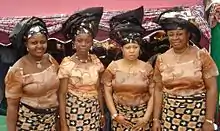 A group of Nigerian women wearing pagne.
A group of Nigerian women wearing pagne. Toghu or tugh is the official traditional regalia of Cameroon worn by men, women and children.
Toghu or tugh is the official traditional regalia of Cameroon worn by men, women and children.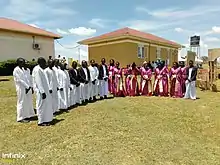
 Traditional gandoura in Algeria
Traditional gandoura in Algeria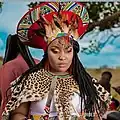 Zulu traditional attire in South Africa
Zulu traditional attire in South Africa Yoruba men in folk costume in Nigeria
Yoruba men in folk costume in Nigeria Kamntole clothes in Seychelles
Kamntole clothes in Seychelles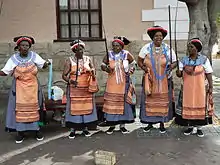
.jpg.webp) A Moroccan women wearing Takshita in 1939
A Moroccan women wearing Takshita in 1939 Kitenge dress in Kenya
Kitenge dress in Kenya
Asia
_(14801964123).jpg.webp) Ancient Babylonia Clothing
Ancient Babylonia Clothing.JPG.webp) Ancient Assyria Clothing
Ancient Assyria Clothing.jpg.webp) Traditional dress in China
Traditional dress in China Japanese traditional dress
Japanese traditional dress Traditional dress in Vietnam
Traditional dress in Vietnam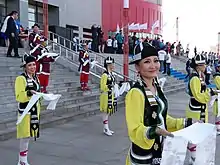 National costume of Mongolia
National costume of Mongolia Tuvan horse-riders wearing deel.
Tuvan horse-riders wearing deel. Indian cultural dresses
Indian cultural dresses._(2517376127).jpg.webp) Cambodian Sompot Chong Kben
Cambodian Sompot Chong Kben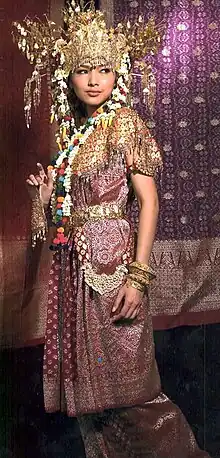
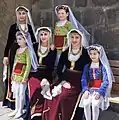 Armenians women wearing a Arkhalig.
Armenians women wearing a Arkhalig. Palestinian costume from Bethlehem.
Palestinian costume from Bethlehem..jpg.webp) Filipino young woman wearing a Maria Clara gown or Traje de mestiza
Filipino young woman wearing a Maria Clara gown or Traje de mestiza Women wearing a Hanbok traditional dress in Korean
Women wearing a Hanbok traditional dress in Korean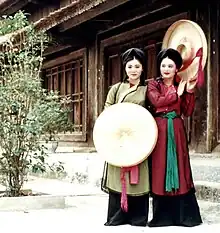 Vietnamese traditional dress
Vietnamese traditional dress Thai traditional dress
Thai traditional dress The Afghan children wearing a traditional clothes
The Afghan children wearing a traditional clothes.jpg.webp)
 The King Faisal and Arabians wearing traditional clothes when from visiting US President Richard Nixon
The King Faisal and Arabians wearing traditional clothes when from visiting US President Richard Nixon A women wearing Ruqun in China
A women wearing Ruqun in China Two Malay women wearing Baju Kurung
Two Malay women wearing Baju Kurung
Europe
 In Ancient Greek a statue wearing Chiton
In Ancient Greek a statue wearing Chiton Two statue both women and men are wearing Himation in Ancient Greek
Two statue both women and men are wearing Himation in Ancient Greek_01.jpg.webp) A status has example of Stola in Ancient Roman Empire for women
A status has example of Stola in Ancient Roman Empire for women For men in Ancient Roman Empire wearing a Toga
For men in Ancient Roman Empire wearing a Toga
 Andalusian folk costumes from Spain
Andalusian folk costumes from Spain
_01a_by_shakko.jpg.webp) Russian tradional dress
Russian tradional dress A group of teens are wearing a Romanian traditional clothes
A group of teens are wearing a Romanian traditional clothes%252C_by_Cletofonte_Preti.jpg.webp) Italian traditional dress (c.1869)
Italian traditional dress (c.1869) Greek traditional dress
Greek traditional dress Turkish folk dancer with traditional dress
Turkish folk dancer with traditional dress National clothes in Hungary
National clothes in Hungary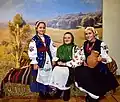 A three women wearing a Vyshyvanka tradional clothes in Ukraine
A three women wearing a Vyshyvanka tradional clothes in Ukraine Traditional Łowicz dress in Poland
Traditional Łowicz dress in Poland
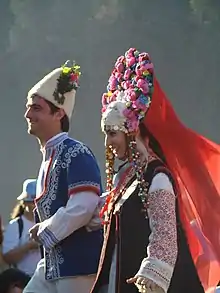 Bulgarian traditional clothes
Bulgarian traditional clothes English dancers wearing Morris folk dancing outfits
English dancers wearing Morris folk dancing outfits
North America
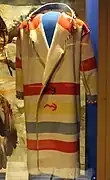 A Siksika Blackfoot capote; the capote is seen as the traditional coat of the Métis, some Prairie First Nations and French-Canadian Voyageurs.
A Siksika Blackfoot capote; the capote is seen as the traditional coat of the Métis, some Prairie First Nations and French-Canadian Voyageurs. Mayan folk clothing from Nebaj.
Mayan folk clothing from Nebaj..jpg.webp) Charro is men wearing from Mexico
Charro is men wearing from Mexico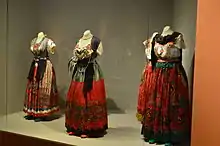 China Poblana dress, emblematic of the City of Puebla and sometimes considered the national costume of Mexico.
China Poblana dress, emblematic of the City of Puebla and sometimes considered the national costume of Mexico. A two women wearing Pollera in Panama
A two women wearing Pollera in Panama
 Ulster American folk costume worn in a museum in Northern Ireland; Ulster Americans primarily lived in the Appalachian region
Ulster American folk costume worn in a museum in Northern Ireland; Ulster Americans primarily lived in the Appalachian region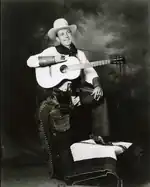 Cowboy attire is a example of Western wear from Western America
Cowboy attire is a example of Western wear from Western America.jpg.webp)
South America
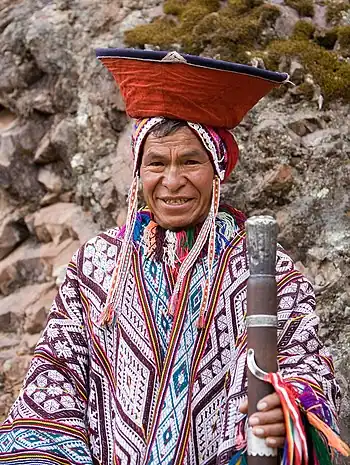 An Peruvian man in traditional dress
An Peruvian man in traditional dress Baiana wearing from Brazil
Baiana wearing from Brazil Argentinian man wearing a Gaucho.
Argentinian man wearing a Gaucho.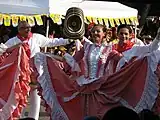 A Cumbia (Colombia) dancer holding a Sombrero vueltiao.
A Cumbia (Colombia) dancer holding a Sombrero vueltiao.
Notes
- See wikt:costume#Usage notes
- "https://www.whattowearonvacation.com/destinations/asia-far-east/bangladesh/134-what-to-wear-in-bangladesh/". whattowearonvacation. Retrieved 19 July 2023.
{{cite news}}: External link in|title= - "Folk costume". estonica.org. Retrieved 7 February 2022.
- "Носиите – Жеравна 2014". Nosia.bg. 2013-06-16. Retrieved 2014-08-27.
- "Български народни носии – България в стари снимки и пощенски картички". Retrobulgaria.com. Retrieved 2014-08-27.
- Condra, Jill, ed. (2013). Encyclopedia of National Dress, Vol. I. Santa Barbara, CA: ABC-CLIO. p. 123. ISBN 9780313376375.
- Condra, Jill, ed. (2013). Encyclopedia of National Dress, Vol. I. Santa Barbara, CA: ABC-CLIO. p. 123. ISBN 9780313376375.

